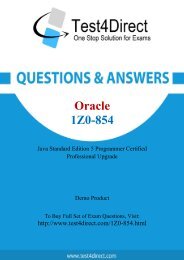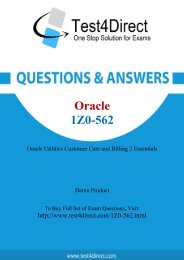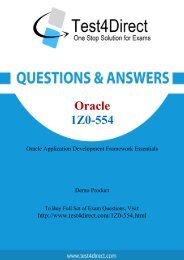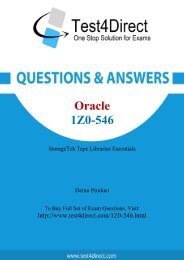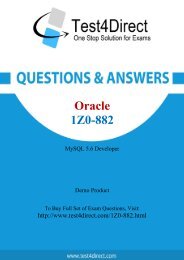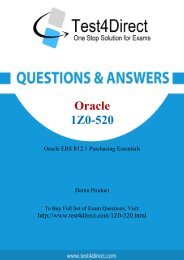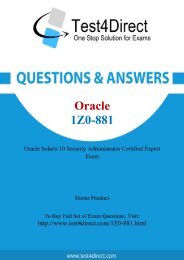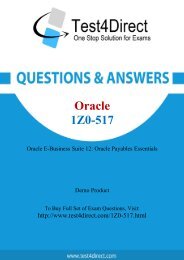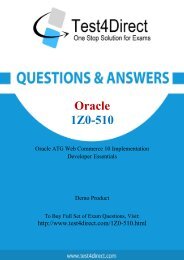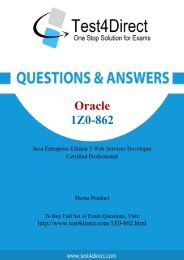Here you get free 1Z0-820 Exam BrainDumps
Test4Direct provides latest PDF questions of Oracle 1Z0-820 exam. You have an opportunity to pass the Oracle 1Z0-820 exam in one go. Test4Direct is most accurate source to prepare Oracle 1Z0-820 exam as your success will become site’s responsibility after purchasing 1Z0-820 exam product. There are also lots of discounts and promotion offers that you can avail. Let’s try a free demo http://www.test4direct.com/1Z0-820.html
Test4Direct provides latest PDF questions of Oracle 1Z0-820 exam. You have an opportunity to pass the Oracle 1Z0-820 exam in one go. Test4Direct is most accurate source to prepare Oracle 1Z0-820 exam as your success will become site’s responsibility after purchasing 1Z0-820 exam product. There are also lots of discounts and promotion offers that you can avail. Let’s try a free demo http://www.test4direct.com/1Z0-820.html
You also want an ePaper? Increase the reach of your titles
YUMPU automatically turns print PDFs into web optimized ePapers that Google loves.
Oracle<br />
<strong>1Z0</strong>-<strong>820</strong><br />
Upgrade to Oracle Solaris 11 System Administrator<br />
Demo Product<br />
To Buy Full Set of <strong>Exam</strong> Questions, Visit:<br />
http://www.test4direct.com/<strong>1Z0</strong>-<strong>820</strong>.html
Question: 1<br />
Identify the two security features incorporated in the Oracle Solaris 11 Cryptographic Framework.<br />
A. Layer 5 IP address encryptions<br />
B. Internet protocol security<br />
C. Diffie-Kerberos coaxial key encryption<br />
D. Signed cryptographic plugins (providers)<br />
E. Kernel support for signed antivirus plugins<br />
Question: 2<br />
Answer: D, E<br />
Explanation:<br />
The framework enables providers of cryptographic services to have their services used by many<br />
consumers in the Oracle Solaris operating system. Another name for providers is plugins. The<br />
framework allows three types of plugins:<br />
* User-level plugins - Shared objects that provide services by using PKCS #11 libraries, such as<br />
pkcs11_softtoken.so.1.<br />
* Kernel-level plugins - Kernel modules that provide implementations of cryptographic algorithms in<br />
software, such as AES.<br />
Many of the algorithms in the framework are optimized for x86 with the SSE2 instruction set and for<br />
SPARC hardware.<br />
* Hardware plugins - Device drivers and their associated hardware accelerators. The Niagara chips,<br />
the ncp and n2cp device drivers, are one example. A hardware accelerator offloads expensive<br />
cryptographic functions from the operating system. The Sun Crypto Accelerator 6000 board is one<br />
example.<br />
Reference: Oracle Solaris Cryptographic Framework<br />
http://docs.oracle.com/cd/E19963-01/html/821-1456/scf-10.html<br />
Review the ZFS dataset output that is displayed on <strong>you</strong>r system:<br />
Which four correctly describe the output?<br />
A. /data/file4 has been added.<br />
B. The link /data/file3 has been added.<br />
C. /data/file3 has been renamed to /data/file13.<br />
D. /data/file4 has been modified and is now larger.<br />
E. /data/file1 has been deleted.<br />
F. /data/file1 has been modified and is now smaller.<br />
G. /data/file5 has been modified.<br />
H. /data/file3 (a link) has been removed.
Question: 3<br />
Answer: A, C, E, G<br />
Explanation:<br />
A: + Indicates the file/directory was added in the later dataset<br />
C: R Indicates the file/directory was renamed in the later dataset<br />
E: - Indicates the file/directory was removed in the later dataset<br />
G: M Indicates the file/directory was modified in the later dataset<br />
Note: Identifying ZFS Snapshot Differences (zfs diff)<br />
You can determine ZFS snapshot differences by using the zfs diff command.<br />
The following table summarizes the file or directory changes that are identified by the zfs diff<br />
command.<br />
File or Directory Change Identifier<br />
* File or directory is modified or file or directory link changed<br />
M<br />
* File or directory is present in the older snapshot but not in the newer snapshot<br />
—<br />
* File or directory is present in the newer snapshot but not in the older snapshot<br />
+<br />
* File or directory is renamed<br />
R<br />
Which five statements describe options available for installing the Oracle Solaris 11operating system<br />
using the installation media?<br />
A. You can perform a text or LiveCD installation locally or over the network.<br />
B. The text Installer does not install the GNOME desktop. The GNOME desktop package must he<br />
added after <strong>you</strong> have installed the operating system.<br />
C. The LiveCD Installation cannot be used to install multiple instances of Oracle Solaris.<br />
D. The LiveCD installer cannot be used if <strong>you</strong> need to preserve a specific Solaris Volume Table of<br />
Contents (VTOC) slice in <strong>you</strong>r current operating system.<br />
E. The LiveCD Installer is for x86 platforms only.<br />
F. The GUI installer cannot be used to upgrade <strong>you</strong>r operating system from Solaris 10.<br />
G. If <strong>you</strong> are installing Oracle Solaris 11 on an x86-based system that will have more than one<br />
operating system installed in it, <strong>you</strong> cannot partition <strong>you</strong>r disk during the installation process.<br />
H. The LiveCD installer can be used for SPARC or x86 platforms.<br />
Answer: A, B, D, F<br />
Explanation:<br />
A: If the network is setup to perform automated installations, <strong>you</strong> can perform a text installation over<br />
the network by setting up an install service on the network and selecting a text installation when the<br />
client system boots.<br />
B: After a fresh install of Solaris 11 express, only the console mode is activated.<br />
To add Gnome, simply do :<br />
$ sudo pkg install slim_install<br />
This will install additional packages that are not installed by default.<br />
D: The text installer advantages over the GUI installer include:<br />
* In addition to modifying partitions, the text installer enables <strong>you</strong> to create and modify VTOC slices
within the Solaris partition.<br />
F: How do I upgrade my Solaris 10 or lower systems to Solaris 11?<br />
Unfortunately, <strong>you</strong> CAN'T. There is no direct upgrade installer or other tool that will allow <strong>you</strong> to<br />
upgrade from earlier releases of Solaris to Solaris 11. This is primarily due to the vast changes in the<br />
packaging mechanism in Solaris 10.<br />
Incorrect answers:<br />
E: Both installers can be used to install Oracle Solaris on the x86 platform. The text installer can also<br />
be used to install Oracle Solaris on the SPARC platform.<br />
G: Both installers enable <strong>you</strong> to select, create, or modify disk partitions during an installation.<br />
H: Both installers can be used to install Oracle Solaris on the x86 platform. The text installer can also<br />
be used to install Oracle Solaris on the SPARC platform.<br />
Reference: Oracle Solaris 11 Information Library, Comparing Installation Options<br />
Question: 4<br />
When setting up Automated Installer (AI) clients, an interactive tool can be used to generate a<br />
custom system configuration profile. The profile will specify the time zone, data and time, user and<br />
root accounts, and name services used for an AI client installation. This interactive tool will prompt<br />
<strong>you</strong> to enter the client information and an SC profile (XML) will be created. Which interactive tool can<br />
be used to generate this question configuration?<br />
A. sys-unconfig<br />
B. installadm set-criteria<br />
C. sysconfig create-profile<br />
D. installadm create-profile<br />
Question: 5<br />
Answer: B<br />
Explanation:<br />
Use the installadm set-criteria command to update the client criteria associated with an AI manifest<br />
that <strong>you</strong> already added to a service using installadm add-manifest.<br />
Use the installadm add-manifest command to add a custom AI manifest to an install service.<br />
The value of manifest is a full path and file name with .xml extension. The manifest file contains an AI<br />
manifest (installation instructions). The manifest file can also reference or embed an SC manifest<br />
(system configuration instructions).<br />
Incorrect answers:<br />
A: The sys-unconfig command is used to restore a system's configuration to<br />
an "as-manufactured" state, ready to be reconfigured again.<br />
C: You can use the sysconfig create-profile command to create a new system configuration profile.<br />
The sysconfig command affects all functional groupings in the Solaris instance.<br />
D: Use the installadm create-profile command to add a system configuration profile to an install<br />
service. The create-profile subcommand validates profiles before adding them to the install service.<br />
Specify criteria so that appropriate clients select that configuration profile. If no criteria are specified,<br />
all clients use this profile.<br />
Review the zonestat command:<br />
zonestate - q physical - memory -R high -z -p -p “zones” 10 24h 60m<br />
Select the option that correctly describes the information that is displayed by this command.
A. It is a sample of dbzone’s physical memory usage taken every hour over a 24-hour period.<br />
Only the top 10 samplings of peak memory usage are displayed.<br />
All other utilization data is eliminated.<br />
B. It is a sample of dbzone’s CPU, virtual memory, and networking utilization.<br />
Physical memory is executed from the report.<br />
The sampling is taken every 10 minutes over a 24-hour period and peak utilization id displayed each<br />
hour.<br />
C. It is a sample of dbzone’s CPU, virtual memory, and networking utilization.<br />
Physical memory is executed from the report.<br />
The sampling is taken every 10 minutes over a 24-hour period and displayed each hour.<br />
D. It is a sample of dbzone’s physical memory usage taken every 10 seconds and 24-hour period.<br />
Only peak virtual memory usage and CPU utilization are displayed each hour.<br />
All other Utilization data is eliminated.<br />
E. It is a sample of dbzone’s physical memory usage taken every 10 seconds and 24-hour period.<br />
Only peak memory usage is displayed each hour.<br />
All other utilization data is eliminated.<br />
Question: 6<br />
Answer: D<br />
Explanation:<br />
* (Not A, B, C): interval (here 10 seconds): Specifies the length in seconds to pause between each<br />
interval report.<br />
* duration (here 24 h)<br />
* -R report[,report] (here high)<br />
Print a summary report.<br />
high Print a summary report detailing the highest usage of each resource and zone during any<br />
interval of the zonestat utility invocation.<br />
Note: The zonestat utility reports on the cpu, memory, and resource control utilization of the<br />
currently running zones. Each zone's utilization is reported both as a percentage of system resources<br />
and the zone's configured limits.<br />
The zonestat utility prints a series of interval reports at the specified interval. It optionally also prints<br />
one or more summary reports at a specified interval.<br />
The default output is a summary of cpu, physical, and virtual memory utilization. The -r option can be<br />
used to choose detailed output for specific resources.<br />
You are configuring NFS on a server. Select the two statements that are true.<br />
A. Resources listed in /etc/dfs/dfstab are automatically shared on boot up.<br />
B. A directory cannot be shared if a subdirectory below it is already shared.<br />
C. Renaming a share created with the zfs set share command is not supported.<br />
D. NFS and SMB protocols cannot be used simultaneously to share the same directory.<br />
Answer: A, C<br />
Explanation:<br />
A: ZFS can automatically share file systems by setting the sharenfs property. Using this property, <strong>you</strong><br />
do not have to modify the /etc/dfs/dfstab file when a new file system is shared. The sharenfs
property is a comma-separated list of options to pass to the share command. The value on is an alias<br />
for the default share options, which provides read/write permissions to anyone. The value off<br />
indicates that the file system is not managed by ZFS and can be shared through traditional means,<br />
such as the /etc/dfs/dfstab file. All file systems whose sharenfs property is not off are shared during<br />
boot.<br />
Incorrect answers:<br />
D: A share can define options for both NFS and SMB sharing.<br />
Question: 7<br />
You have already generated a 256-bit AES raw key and named the keystore file /mykey. You need to<br />
use the key to create an encrypted file system. Which command should <strong>you</strong> use to create a ZFS<br />
encrypted file system named pool1/encrypt using the /mykey keystore?<br />
A. zfs create - o encryption = /mykey pool1/encrypt<br />
B. zfs create - o encryption = 256-ccm - o keysource = raw, file : ///my key pool1/encrypt<br />
C. zfs create - o encryption = AES keysource = /mykey pool1/encrypt<br />
D. zfs create - o encryption = on keystore = /mykey pool1/encrypt<br />
Answer: B<br />
Explanation:<br />
<strong>Exam</strong>ple: Encrypting a ZFS File System by Using a Raw Key<br />
In the following example, an aes-256-ccm encryption key is generated by using the pktool command<br />
and is written to a file, /cindykey.file.<br />
# pktool genkey keystore=file outkey=/cindykey.file keytype=aes keylen=256<br />
Then, the /cindykey.file is specified when the tank/home/cindy file system is created.<br />
# zfs create -o encryption=aes-256-ccm -o keysource=raw,file:///cindykey.file tank/home/cindys<br />
Reference: Oracle Solaris ZFS Administration Guide, <strong>Exam</strong>ples of Encrypting ZFS File Systems
THANKS FOR TRYING THE DEMO OF OUR PRODUCT<br />
Visit Our Site to Purchase the Full Set of Actual <strong>1Z0</strong>-<strong>820</strong> <strong>Exam</strong> Questions With Answers.<br />
http://www.test4direct.com/<strong>1Z0</strong>-<strong>820</strong>.html<br />
We Also Provide Practice <strong>Exam</strong> Software That Simulates Real <strong>Exam</strong> Environment And Has<br />
Many Self-Assessment Features. Download Free Product Demo From:<br />
http://www.test4direct.com/<strong>1Z0</strong>-<strong>820</strong>.html<br />
Money Back Guarantee<br />
Check Out Our Customer Testimonials






